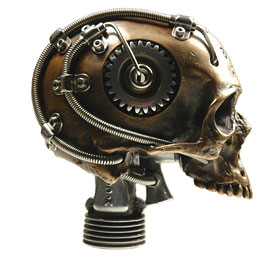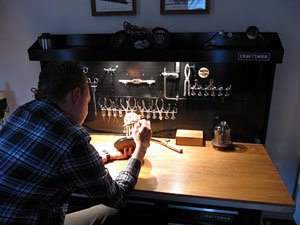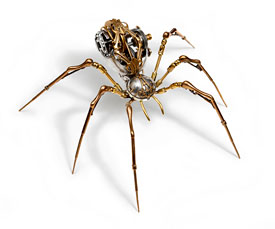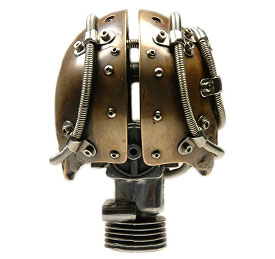Sci-Fi Meets Tech in Conte's World
 BioMechanical Bronze Skull, Version 1, 2006 by Christopher Conte. Casted hand finished and machined bronze with stainless steel and aluminum components.
BioMechanical Bronze Skull, Version 1, 2006 by Christopher Conte. Casted hand finished and machined bronze with stainless steel and aluminum components.Photograph courtesy of Christopher Conte
The sculptural work of artist Christopher Conte, 43, has garnered a unique following. From the FBI counterterrorism force to tech gurus, sci-fi buffs and art aficionados, Conte is just as apt to have his work displayed in a gallery or museum, as he is to have it go viral after being featured in a tech magazine or blog.
Conte's interest in three-dimensional work culminated through his studies in illustration at Pratt Institute in Brooklyn, New York.
"I think I liked building things more than I liked painting pictures of things," Conte says.
It was in college where he also developed an affinity for anatomy.
"One of the things I started to learn about in college is the human body in order to be able to draw a person," he says. "Through that process I developed a deep appreciation for the human body."
This appreciation has always been the foundation upon which most of his sculptures are based.
"My work is very much realism," Conte says, describing how he uses an eye similar to an engineer's approach. "I want to convey the inner substructures of a particular mechanism or organism - I want to make it look like it could actually work."
After graduating from Pratt, he pondered an occupation that would suit his artistic interests in mechanical work.
"One day it occurred to me to look up artificial limbs in the phone book" he says. "I realized I loved that kind of stuff - I was always fascinated by the world of medicine and science."
 Christopher Conte at work in his studio.
Christopher Conte at work in his studio.Photograph courtesy of Christopher Conte
On his first interview upon showing his portfolio, his radio controlled heads and cable controlled arms received favorable feedback.
"He said they were more advanced than what we're doing in the field right now," Conte says of the man who interviewed him for the job.
A three-month trial period turned into a 16-year career as a certified prosthetist.
He left the field in 2008 to devote more time to creating sculptures after his success in a solo show in New York City.
"I realized there is no way I'm going to be able to produce enough if I'm working full-time," he says.
Conte strives for his work to convey a "timeless beauty" which steers him clear of using such items as modern electronics. Instead he opts to use the inner workings of older mechanical objects so as not to date his work.
"What I try to do is capture and imply motion or movement," he says. "I ask myself how can I convey something that could get up and move-- how could this thing really work in a real world environment."
With a self-taught background in robotics, old machines and mechanical movement, attributes such as working joints and hydraulics, are most appealing to him.
"I try to envision or imagine the substructure of these things," Conte says. "The joints and the emotions implied within the form."
 Victoria, 2012 by Christopher Conte. Cast bronze with stainless steel and carbon steel components.
Victoria, 2012 by Christopher Conte. Cast bronze with stainless steel and carbon steel components.Photograph courtesy of Christopher Conte
Think gears and cogs to imply movement versus flipping a switch to activate something to move.
"It has no real purpose other than as art and to inspire," he says of his work.
Conte's interpretation of skulls, insects, biomechanical arms and droids are common fare, among other one-of-a-kind sculptures he creates---preferred forms he can use to reveal their inner workings.
In creating his work, which is a four to six-week process per sculpture, Conte refers to an "old school" approach he takes in making his pieces.
"I really don't use any sketches and I don't use a computer---no CAD (Computer Aided Design) work or anything along those lines," Conte says. "I have a picture in my head and find the parts to produce what I want to make."
In the past two years, Conte's work has appeared in at least fifty group and solo shows in galleries worldwide.
"Now I'm moving away from doing gallery shows and dealing more directly with collectors," he says, adding he completed three commissioned works this summer.
He says the Internet has played a vital role in his work garnering a following in the last two years that aided in him making a name for himself in both the art and tech world.
"The images have a viral effect at this point. They have a life of their own," Conte says.
From his work being featured on tech blogs, Wired and Popular Science magazines, TLC and the Discovery Channel, Conte said it's not just art buffs that are drawn to his work, but also sci-fi buffs and tech gurus.
"It speaks to them in a way where maybe your typical art might not," he says.
 BioMechanical Bronze Skull, Version 1, 2006 (rear view) by Christopher Conte. Casted hand finished and machined bronze with stainless steel and aluminum components.
BioMechanical Bronze Skull, Version 1, 2006 (rear view) by Christopher Conte. Casted hand finished and machined bronze with stainless steel and aluminum components.Photograph courtesy of Christopher Conte
Creating sculptures isn't the sole passion in Conte's artistic life.
"Through the process of finding parts for my projects I developed an affinity for antiques," Conte says. "I'm looking for antique sewing machine parts and the next thing I find is a sewing machine - I like the idea of having something like that in my living room."
He and his wife, Jacquelyn, 36, share an appreciation for things made in the past.
"Things were made better 100 years ago," Conte says. "The materials are usually better quality - I find inspiration in objects through history."
Aside from being a collector, he is also a part-time antiques dealer.
"We just love doing it," he says. "As an artist you kind of look at things with an artful eye and see the beauty of the past. You can't help but be drawn to it."
Since the process of acquiring individual parts to create sculptures requires the dismantling of objects, preserving history when salvaging is a priority for Conte.
"I don't repurpose anything that is extremely rare or in exceptional condition," he says.
Conte chooses to stockpile parts he finds when out scouring flea markets, visiting hobby shops, searching on eBay or simply coming across discarded items left on the side of the road.
"I buy it when I see it," he says, regardless of when he may end up needing it. "I stockpile a tremendous amount of parts---I have 50,000 small parts in my studio organized in small chests of drawers."
One drawer might consist of pocket watch movements and another, watch wristbands. Brass items are stored in one drawer and bronze in the other.
Due to the categorization system he developed, he can easily locate a part when in the process of creating his work.
Conte's approach typically starts with parts he knows he has in his inventory.
"I draw pictures in my head based on some of the parts I know I have," Conte says.
Despite having thousands of parts from which to choose, narrowing in on particular parts that serve as inspiration is never an issue for Conte.
"I have a bit of a photographic memory when it comes to these parts," he says.
While Conte is inspired by and drawn to some objects from the Victorian and steam engine era, he doesn't like to be branded as solely a Steampunk genre artist.
"It can pigeon hole you a little bit," he said. "My stuff bridges out into other territories - it is something I have done and continue to be inspired by. I try to really take my art to a whole new level."
Conte's studio is home-based in Locust Valley on the north shore of Long Island in New York.
"It's a very small studio where I stockpile parts, he says, adding it is equipped with a drill press and a small lathe.
Thanks to a friend's introduction to one of the owners of a prototyping shop in Hicksville, New York, Conte has full access to the workshop at any time. It is located just fifteen minutes from his studio. He typically takes metal parts to the shop to machine, grind, sand and polish, among other things.
"It's a shop of a company that specializes in prototypes for the aerospace industry," he says.
Brass, bronze, and stainless steel are metals with which he enjoys working.
"Many copper alloys are great for soldering, welding, pounding -- it is one the easiest materials to machine as well," Conte says.
There are other aspects of using copper alloys he appreciates.
"I like the ability you have to work the surface later on and even the range of colors you can produce using acids and chemicals," Conte says. "Creating patinas on the surface add an incredible dimension to the work - it opens up a whole realm of possibilities."
He likes the "antique science instrument look" of brass in addition to being able to shape it faster than working with steel.
Conte uses the lost wax casting process when working with bronze.
"It's neat because it's a technology that goes back 5,000 years," he says.
Conte casts his own components when a vision calls for it, some of which are found parts and others of which he sculpts himself.
"I might need ten of something and only have one," he says. "It's a way to reproduce a part with exact scale and precision."
Given the right circumstances and adequate funding, don't be surprised to see some of Conte's future sculptures actually come to life.
"I try to keep breakthrough technology in the back of my mind," he says. "You can't build this stuff without thinking about how it might work at some point."
Resources:
Also in this Issue:
- Sci-Fi Meets Tech in Conte's World
- The Electrifying Copper of Drury Lane Studios
- The ArtistSandbox: LED NightLight Rings Illuminate Evening Hours Between Copper and Brass
- Whim Originals: Unique Jewelry with An Industrial Edge
- Masterworks by Tiffany Studios from the Geyer Family Collection to be Offered at Sotheby's
